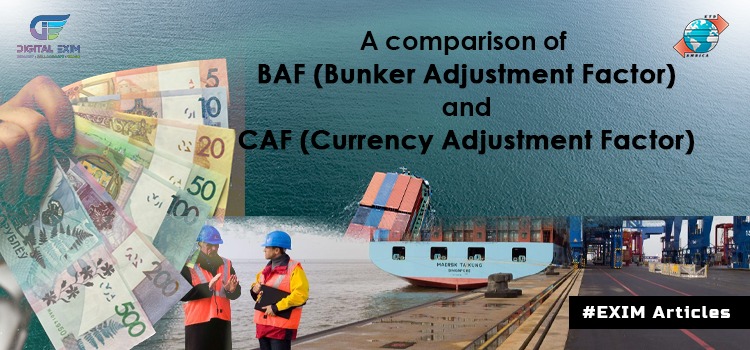Do you also wonder what is BAF & CAF and how does it work in international business? So, Let’s begin with the difference of both the factors. For more details get connected with export import training. BAF stands for Bunker Adjustment Factor, and CAF stands for Currency Adjustment Factor. BAF and CAF are generally attributed by sea shipping carriers. These are fees added to ocean freight at various times depending on the destination.
What is BAF?
Fuel factor costs supplement ocean freight by shipping companies when oil prices fluctuate globally, therefore, requiring the BAF surcharge on the ocean freight. This surcharge is added up on the ocean freight by shipping companies to supplement fuel factor costs and is termed as BAF.
What is CAF?
The CAF is a charge added to the basic ocean freight by sea shipping carriers as a result of fluctuating exchange rates. CAF is a part of ocean freight that balances and caters against differences in currency value fluctuations. It is an adjustment factor applied to freight rates to minimize or control losses or gains. In short, the main difference between BAF and CAF is that BAF is related to oil prices, while CAF is related to foreign currency prices. Did you like our article on BAF and CAF? This is a part of our online course. Join our online import export course and know more.
For More Knowledge Read Our Article On-
Difference Between High Sea Sale and ImportsWhat does a Line Number in IGM mean? What is IHC- Inland Haulage Charges? FIRC In Export And Import Business Documentation of High Sea Sales What is Triangular Shipment ?What Is E-Commerce Under GST? What Is Port Of Discharge And Place Of DeliveryDifferent Types of Export Containers What is FCL in Export Import? Steps to Become Successful in Trade for Start-ups What is Mother Vessel and Feeder Vessel What is co-loading? What is ICD?
What is SWOT Analysis and Why it is Important for Business?
Role of Indian Embassy in Export ImportWhat is Registration Cum Membership Certificate? What is DGFT and Its Role? What is Bill of Exchange? What is a Letter of Credit?
What is High Sea Sales? What Does DGFT Grant to Indian Importers & Exporters?
Watch Our YouTube Videos On-
https://www.youtube.com/watch?v=rrHdoF4RJjA&t=2shttps://www.youtube.com/watch?v=kO2ekPQke8whttps://www.youtube.com/watch?v=C4H8yLWDOm8&t=1shttps://www.youtube.com/watch?v=tyI7RFtpaRg&t=1shttps://www.youtube.com/watch?v=y4bXUAtMY8A&t=12shttps://www.youtube.com/watch?v=7pMI3vlKEDchttps://www.youtube.com/watch?v=r_4zjeW2Ht8&t=1shttps://www.youtube.com/watch?v=dptTB7HCJtA&t=4shttps://www.youtube.com/watch?v=5aTvyKIc7ks&t=1s
















